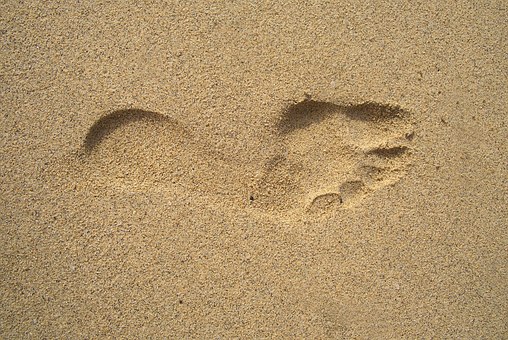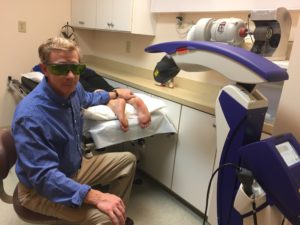A Big Pain in the Foot!

What exactly is Plantar Fasciitis and what can you do?
STORY BY: LESLIE RESCHLY, BSN, RN
I f you have experienced plantar fasciitis, you know the pain! The first steps off your bed in the morning are excruciating! Standing after sitting for a time period is miserable! Along the bottom of each of your feet is a layer of tissue called fascia that provides support to the arch of your foot and connects the toe area to your heel. This is known as the plantar fascia.
Any strain or inflammation of this area causes discomfort along your heel or the bottom of your foot especially when walking. Common to the 40-60 year old age group, this stabbing pain increases with your first steps but then may get better as you move around prior to returning later in your day or especially after exercise. Repeated strain to this area causes tiny tears in the fascia that swell or inflame causing the discomfort.
The following are identified risk factors for plantar fasciitis:
• High arches or flat feet or feet which roll in
• Walking, standing or running on hard surfaces for prolonged periodsespecially in certain occupations • Being overweight which puts added strain on the area
• Wearing high heels or going barefoot on hard surfaces
• Wearing worn out, poor fitting shoes including athletic shoes
• Tight muscles in your calves or along your Achilles tendon in the back of your lower leg
• High impact sports involving running, ballet or aerobic dance
While I encountered plantar fasciitis as a result of going barefoot and wearing flimsy flip flops for an extended period, some people have no idea what first started their symptoms. Since prolonged pain with walking can actually change the way you ambulate and put stress on other joints such as knees, hips and ankles, prompt recognition and treatment may help prevent a chronic condition from developing. Initial treatment is simple…get off your feet! Ice applications for 15-20 minutes three to four times per day may give immediate relief to the inflammation. If your health status allows, use of NSAID medications such as Ibuprofen or Naprosyn may improve the situation.
Calf stretching may also help with lengthening your lower leg muscles. If initial treatment does not change your symptoms, seek prompt medical advice from your healthcare provider. You may be referred to a specialist such a Podiatrist or Orthopedic physician. In addition, you may be sent to Physical Therapy if needed and they will be able to teach you specific stretching exercises for your legs. Special shoes or orthotic devices can assist (orthotics may be recommended in both shoes even if only one foot hurts).
Typically, splints are often used at night to keep your toes flexed toward your leg and stretch your calf leg muscles as you sleep. Reflexology is another non-invasive option you may try for relief of your symptoms. If your condition continues to worsen despite conservative treatment, there are other more invasive options to consider. Steroid injections may be given to provide temporary pain relief but cannot be repeated frequently as they may weaken the tissue. Surgical intervention to detach the fascia from the bone is a last resort and may leave you with potentially worse consequences. Newer and more conservative treatment involves the use of cold laser therapy.

Local podiatrist, Dr. Joseph Kibler DPM, FACFAS, currently uses the MLS “Cutting Edge” laser in his office in Supply, NC to treat plantar fasciitis as well as other conditions. Use of this MLS (Multiwave Locked System) Therapy uses light energy of two wave lengths to stimulate the body’s natural healing process at the cellular level. The laser treats pain, inflammation and edema promoting pain relief with its rapid effects. Dr. Kibler notes that stimulation of the pain receptors on the nerves can temporarily block the pain for 30 minutes to hours AND becomes additive with subsequent treatments therefore providing greater pain relief while decreasing the swelling and promoting the healing of the fascia.
Plus, Kibler reports this cold laser is not painful during use. Frequently, Kibler is able to effectively treat a person who has an acute plantar fasciitis of duration around 1 week with 6 sessions but stated that chronic plantar fasciitis may require as many as 10-12 sessions over a 3-4 week period. Please contact InStride-Brunswick Foot & Ankle Surgery for a consultation. (See info at the end of this article) Insurance does not typically cover this procedure. Despite the use of treatment, plantar fasciitis may take a few months to a year to resolve. During this time, it is important to stick with your treatment plan. In addition, for your health, continue to exercise altering your physical activity to a low impact sport such as biking or swimming. Avoid situations causing prolonged standing or running on hard surfaces and replace worn out athletic shoes!











Leave a Reply